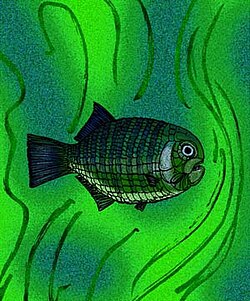| Dandya ovalis Temporal range: | |
|---|---|
 | |
| Artist's reconstruction | |
| Scientific classification | |
| Kingdom: | Animalia |
| Phylum: | Chordata |
| Class: | Actinopterygii |
| Order: | † Dapediiformes |
| Family: | † Dapediidae |
| Genus: | † Dandya Tintori, 1983 |
| Species: | †D. ovalis |
| Binomial name | |
| †Dandya ovalis (Gorjanovic-Kramberger, 1905) | |
| Synonyms | |
| |
Dandya is an extinct genus of marine ray-finned fish belonging to the family Dapediidae. [1] It contains one species, D. ovalis. It is known from the Late Triassic-aged Zorzino Limestone of Lombardy, northern Italy and the Seefeld Formation of Austria. [2] [3] [4] [5]




